ABSTRACT
Background
For driver-negative Non-Small Cell Lung Cancer (NSCLC), platinum-based chemotherapy remains standard; however, carboplatin efficacy is limited by poor tumour delivery and dose-limiting toxicity. In this study, we developed biotin-functionalised polymersomes encapsulating carboplatin to enhance carrier stability and enable selective tumour delivery via sodium-dependent multivitamin transporter uptake.
Materials and Methods
A Box-Behnken design optimised Tetronic® 1107 polymersomes by modelling polymer concentration, temperature, and stirring time against particle size, zeta potential, and entrapment efficiency. The optimised formulation was characterised by dynamic light scattering (particle size distribution); atomic force and scanning electron microscopy (morphology); Fourier-transform infrared spectroscopy (interactions); differential scanning calorimetry (thermal behaviour); and powder X-ray diffraction (crystallinity). It was further evaluated for pH-dependent release and cytotoxicity in biotin-overexpressing A549 cells.
Results
Box-Behnken optimisation yielded SMVT-targeted, biotin-functionalised Tetronic® 1107 polymersomes (PS = 246 nm; ZP = –26 mV; EE = 85%). FTIR, DSC, and XRD showed a preserved PEO/PPO matrix with amorphous carboplatin. AFM and SEM revealed a corrugated, biotin-rich corona. Release was sustained and pH-responsive, fitting the Weibull model (R²=0.93-0.97). In A549 cells, biotin-coated vesicles reduced the IC₅₀ 1.73-fold relative to free carboplatin (p < 0.05).
Conclusion
Biotin-functionalised polymersomes improved carboplatin loading, stability, and tumour-targeted cytotoxicity, supporting their evaluation in vivo for NSCLC therapy.
INTRODUCTION
Non-Small Cell Lung Cancer (NSCLC) constitutes the predominant form of lung cancer (85%), driving high mortality (Sunget al., 2021). In NSCLC lacking targetable driver mutations, carboplatin-based combinations are standard first-line therapy for advanced or metastatic disease, often preferred over cisplatin due to reduced nephrotoxicity and neurotoxicity (Zhanget al., 2022). Carboplatin [cis-diammine(cyclobutane-1,1-dicarboxylato)platinum(II), CBDCA] contains a cyclobutane-dicarboxylate chelate that slows aquation nearly two-fold relative to cisplatin, thereby improving stability, enhancing solubility, and reducing chloride dependence (Obreshkovaet al., 2022). Its active diaqua species form DNA crosslinks at guanine-N7, inducing p53-mediated apoptosis (Fenget al., 2022). Carboplatin is cleared by glomerular filtration with short half-lives (~0.5 hr distribution and ~2.2 hr elimination in plasma) increasing free drug exposure to bone marrow progenitors and causing dose-limiting myelosuppression (Samaniet al., 2022). Despite AUC-guided dosing (5-6 mg·min/mL), neutropenia may occur at 4 mg·min/mL, reflecting a narrow therapeutic index (Millenet al., 2024).
Nanocarriers aim to overcome these limitations, but each faces unique challenges. For example, PEGylated liposomes reduced phagocyte uptake but showed poor tumour penetration (Chenet al., 2025), endosomal trapping (Qiuet al., 2023), accelerated blood clearance (Panet al., 2025) and hypersensitivity (Ibrahimet al., 2022). PEGylated liposomes with doxorubicin and carboplatin released 56% of drug within 52 hr. (Ghaferiet al., 2022) and also one study reported 2.2% payload with 58.5% encapsulation efficiency (Hadisadeghet al., 2024) and modest survival benefits in F98-glioma rats (Shiet al., 2018). Other strategies, like Pluronic® micelles, disassemble below the critical micelle concentration, causing premature drug release after dilution. (Gaucheret al., 2005), Similarly, poly(amidoamine) dendrimers are limited by cationic surface toxicity and complex synthesis (Dehkordiet al., 2025). Such shortcomings have restricted carboplatin nanomedicines from advancing beyond Phase II, highlighting need for stable, selective carriers.
Polymersomes, self-assembled vesicles with thicker bilayers and greater stability than liposomes, provide superior drug retention, prolonged circulation, and facile ligand functionalization (Fonsecaet al., 2024). Tetronic® 1107, a star-shaped poloxamine (70% PEO), offers low CMC, pH/temperature responsiveness, and robust drug loading, outperforming Pluronic® carriers (Alasmaryet al., 2022). Biotin (vitamin B7) targets the sodium-dependent multivitamin transporter, broadly overexpressed in cancers (Wanget al., 2025), and offers greater selectivity than folate (Anithaet al., 2024) or hyaluronic acid systems limited by variable expression and rapid hepatic clearance (Cirillo, 2023). In this study, we aim to develop biotin-functionalised Tetronic® 1107 polymersomes for carboplatin delivery, encompassing pH-responsive bilayers, SMVT-mediated uptake within a Quality-by-Design paradigm.
MATERIALS AND METHODS
Carboplatin (TCI Chemicals, Japan), biotin (Loba Chemie, India), and Tetronic® T1107 (BASF, USA) were used. Dialysis membranes (2.4 nm pore, 12-14 kDa MWCO) were from HiMedia. A549 cells sourced from NCCS, Pune, India. Reagents were analytical grade.
Experimental Design, Optimisation, and Statistics
A Design of Experiments (DoE) framework integrated D-optimal screening (stepping-swapping; maximise |X′X|) and a 3-factor/3-level Box-Behnken design (17 runs; 3 centre points; coded -1/0/+1) to evaluate Tetronic® 1107 concentration (0.5/1.25/2%), temperature (45/52.5/60ºC), and stirring time (0.5/1.25/2 hr) on particle size (PS, [nm]), zeta potential (ZP, [mV]), and Entrapment Efficiency (EE, [%]). Response Surface Methodology (RSM) in Design-Expert® v13 (Stat-Ease, USA) generated second-order models, refined by backward elimination and validated by ANOVA, lack-of-fit tests, and diagnostic checks. Optimisation used Derringer-Suich desirability (minimise PS, target ZP, maximise EE), with predictions experimentally verified. Data are reported as mean±SD (n≥3), with GraphPad Prism 10 applied for one-way ANOVA (p<0.05).
Preparation of Carboplatin-Loaded Polymersomes
Carboplatin-loaded Tetronic® 1107 polymersomes were prepared by solvent-injection. Tetronic® 1107 and carboplatin in methanol were injected into deionised water under stirring and held for the set time (Table 1). In optimised batches, biotin was adsorbed post-assembly onto the PEO-rich surface at room temperature, stirred for 6 hr, then dialysed 24 hr to remove solvent and free drug (Sweedet al., 2025).
| Code | Factor X1: Concentration (%) | Factor X2: Temperature (ºC) | Factor X3: Stirring Time (hr) | RESPONSES Y1: Particle Size (d. nm) | RESPONSES Y2:Zeta Potential (mV) | RESPONSES Y3: Entrapment Efficiency (%) |
|---|---|---|---|---|---|---|
| CF1 | 1.25 | 52.5 | 1.25 | 338.5 | -20.5 | 74.8 |
| CF2 | 1.25 | 52.5 | 0.5 | 227.3 | -24.9 | 75.4 |
| CF3 | 2 | 52.5 | 2 | 269.5 | -22.7 | 66.1 |
| CF4 | 1.25 | 60 | 2 | 388.7 | -17.4 | 80.9 |
| CF5 | 2 | 60 | 1.25 | 779.5 | -16.9 | 69.1 |
| CF6 | 0.5 | 52.5 | 2 | 267.5 | -16.2 | 84.1 |
| CF7 | 1.25 | 45 | 0.5 | 152.6 | -24.7 | 72.7 |
| CF8 | 0.75 | 45 | 0.5 | 220.8 | -25.4 | 67.9 |
| CF9 | 1.25 | 60 | 0.5 | 281.5 | -18.6 | 78.8 |
| CF10 | 1.25 | 60 | 2 | 521.9 | -20.3 | 79.9 |
| CF11 | 1.25 | 52.5 | 1.25 | 536 | -18.2 | 75.9 |
| CF12 | 1.25 | 52.5 | 1.25 | 483.5 | -23 | 76.5 |
| CF13 | 1.25 | 45 | 2 | 206.6 | -19.6 | 72.1 |
| CF14 | 0.5 | 60 | 1.25 | 326.8 | -20.9 | 87.7 |
| CF15 | 1.25 | 52.5 | 0.5 | 275.9 | -24.2 | 78.8 |
| CF16 | 2 | 52.5 | 1.25 | 504.9 | -23.2 | 69.1 |
| CF17 | 0.5 | 52.5 | 0.5 | 223 | -24.1 | 83.6522 |
Physicochemical Evaluation
- Particle size and zeta potential: Particle Size (PS) and Zeta Potential (ZP) were measured by using a Zetasizer Nano ZS-90 (Malvern Instruments, UK).
- Fourier Transform Infrared Spectroscopy (FTIR): FTIR (Shimadzu FTIR-8400S) assessed carboplatin-matrix interactions. 2 mg lyophilised. lyophilised formulation was mixed with KBr, pressed, and scanned (4000-400 cm⁻¹; 15 scans).
- Differential Scanning Calorimetry (DSC): DSC (Mettler Toledo DSC 3) was performed on 9 mg samples in sealed aluminium crucibles, heated from 30 to 300ºC at 10ºC·min–¹.
- X-ray Diffraction Spectroscopy (XRD): XRD (Empyrean, Malvern Panalytical) patterns were recorded using Cu Kα radiation (λ=1.540 Å) over 2θ=10-90° at 10°·min⁻¹ with 0.02° steps (Umar and Samokhvalov, 2024).
- Atomic Force Microscopy (AFM) Analysis: AFM (NTEGRA, NT-MDT) in tapping mode was used to image samples that were drop-cast and air-dried under ambient conditions.
- Scanning Electron Microscopy (SEM): SEM (EVO 18, Carl Zeiss) was applied to image Au/Pd-sputtered samples at 20 kV, with a 10.5 mm working distance and 10,000× magnification.
- Drug Encapsulation: Encapsulation efficiency was determined by ultracentrifugation (12,000 rpm, 45 min, 4ºC), with free drug in the supernatant quantified at 210 nm by UV spectroscopy (Warekar and Kurup, 2025).
In vitro Release
Release from uncoated and biotin-coated polymersomes was studied by dialysis (12-14 kDa MWCO) in phosphate buffer (pH 5.5, 6.8, 7.4; 37ºC). 2 mL formulation was dialysed against 200 mL stirred buffer at 100 rpm, with 5 mL samples withdrawn at intervals (≤24 hr) and replaced with fresh medium. Carboplatin was quantified at 210 nm (Mastet al., 2021).
Cytotoxicity
A549 cells (1 × 10⁴/well) were seeded in 96-well plates with Dulbecco’s Modified Eagle Medium (DMEM) containing 10% Fetal Bovine Serum (FBS) and treated for 24 hr with free carboplatin, uncoated polymersomes, and biotin-coated polymersomes (25-500 μM; 100 μL/well). MTT[3-(4,5-dimethylthiazol-2-yl)-2,5-diphenyltetrazolium bromide, 10 μL, 5 mg·mL⁻¹] assay was performed by incubating for 3 hr, removing the medium, dissolving the formazan crystals in 100 μL Dimethyl Sulfoxide (DMSO), and measuring absorbance at 570 nm. (ref. 630 nm) (Liuet al., 2022).
RESULTS
Statistical Optimisation and validation
Seventeen Box-Behnken runs showed particle sizes of 152.6-779.5 nm, zeta potentials of -25.4 to -16.2 mV, and entrapment efficiencies of 66.1-87.7% (Table 1). 3D response surfaces (Figures 1a-c), overlay desirability plot (Figure 1d), contour (Figures 2a-d), perturbation (Figures 3a-c), and interaction plots (Figures 4a-c), illustrated variable effects on Critical Quality Attributes (CQAs). Model adequacy was established by statistical analysis (Table 2) and diagnostic plots (Figures 5–7). The generated second-order regression equations are given below.
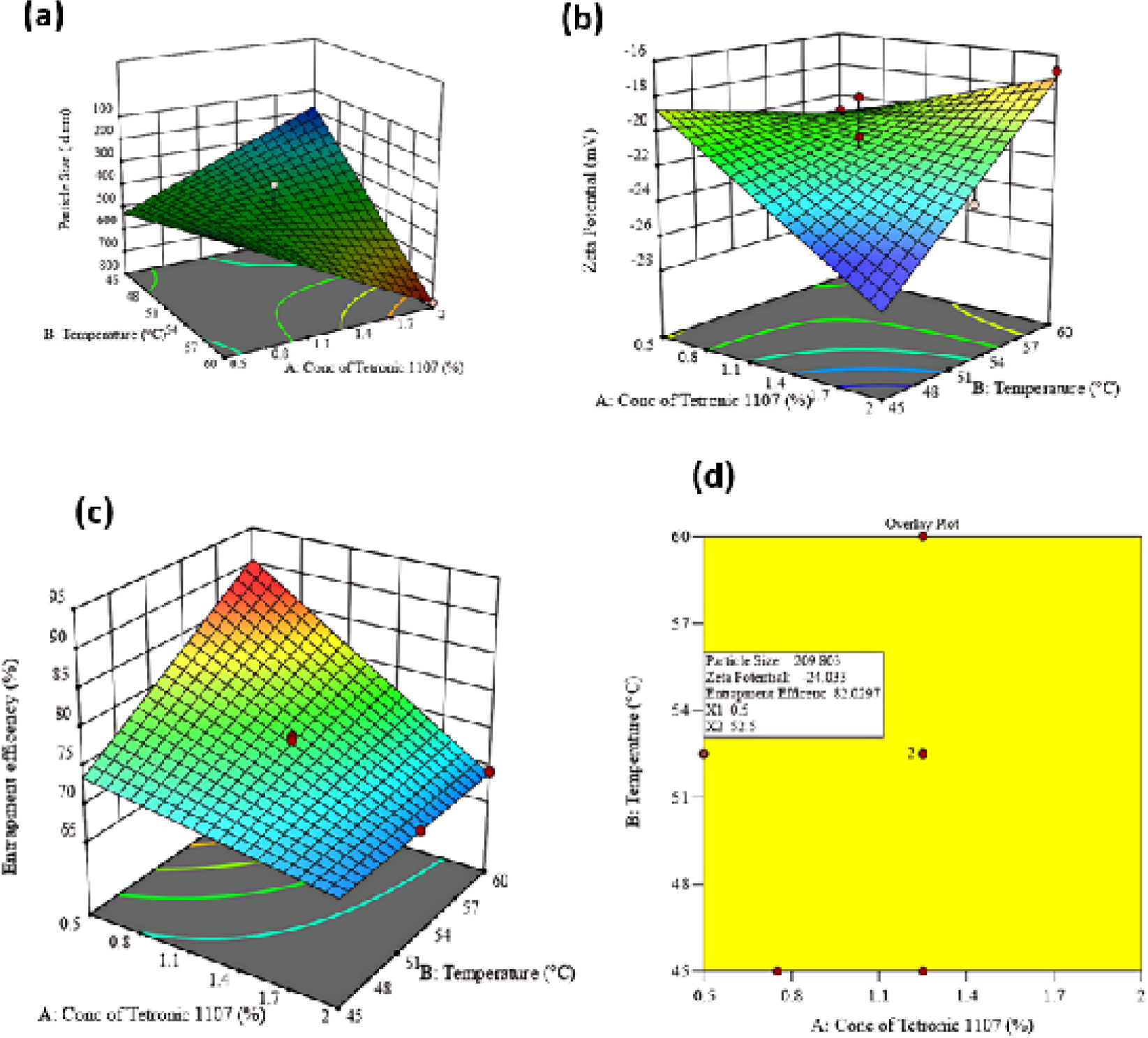
Figure 1:
3D responses: (a) particle size, (b) zeta potential, (c) encapsulation efficiency, and (d) overlay desirability plot.
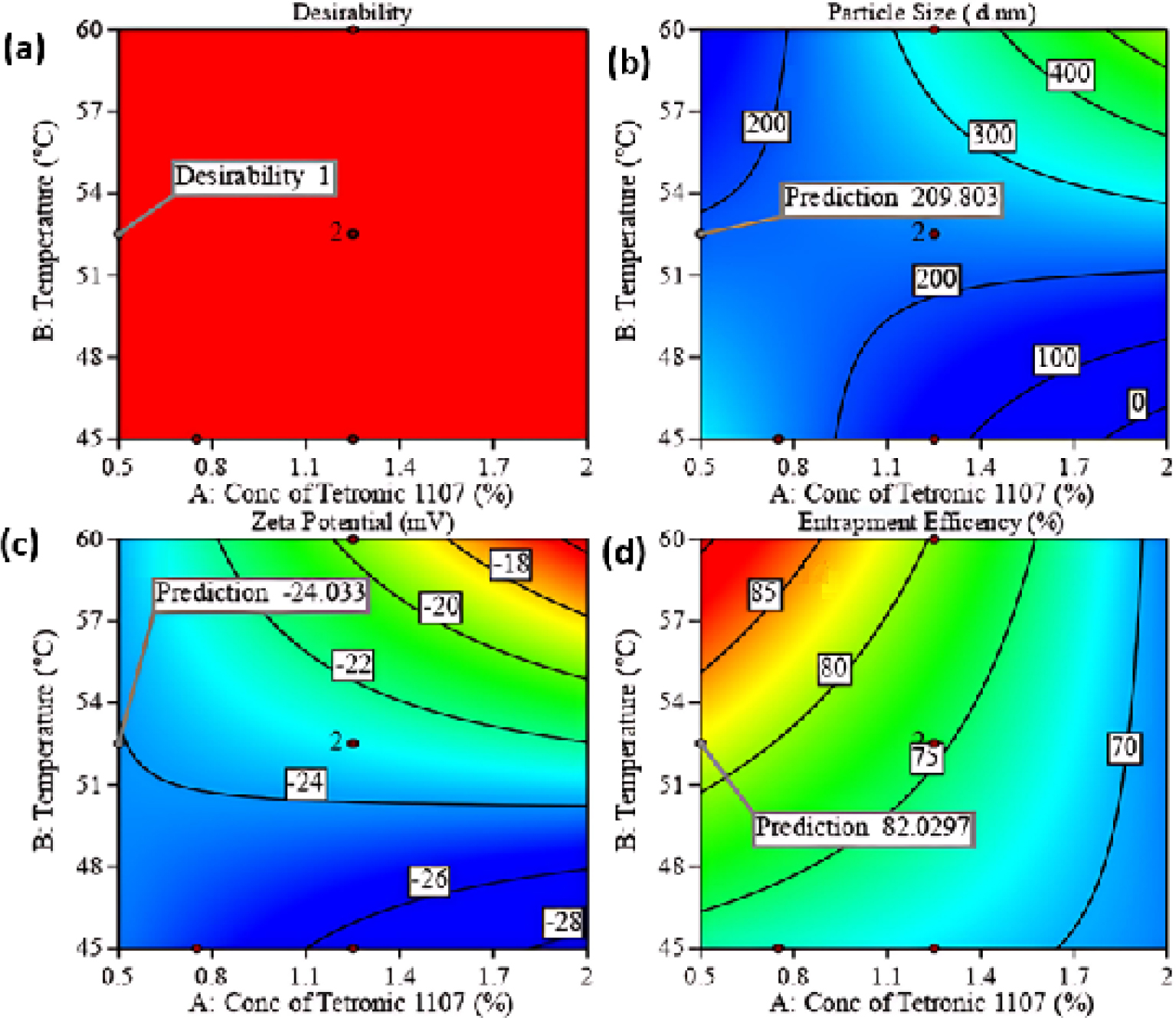
Figure 2:
Contour plots (a) desirability, (b) particle size, (c) zeta potential, and (d) encapsulation efficiency.

Figure 3:
Perturbation plots: (a) particle size, (b) zeta potential, and (c) entrapment efficiency; steeper lines show greater sensitivity.
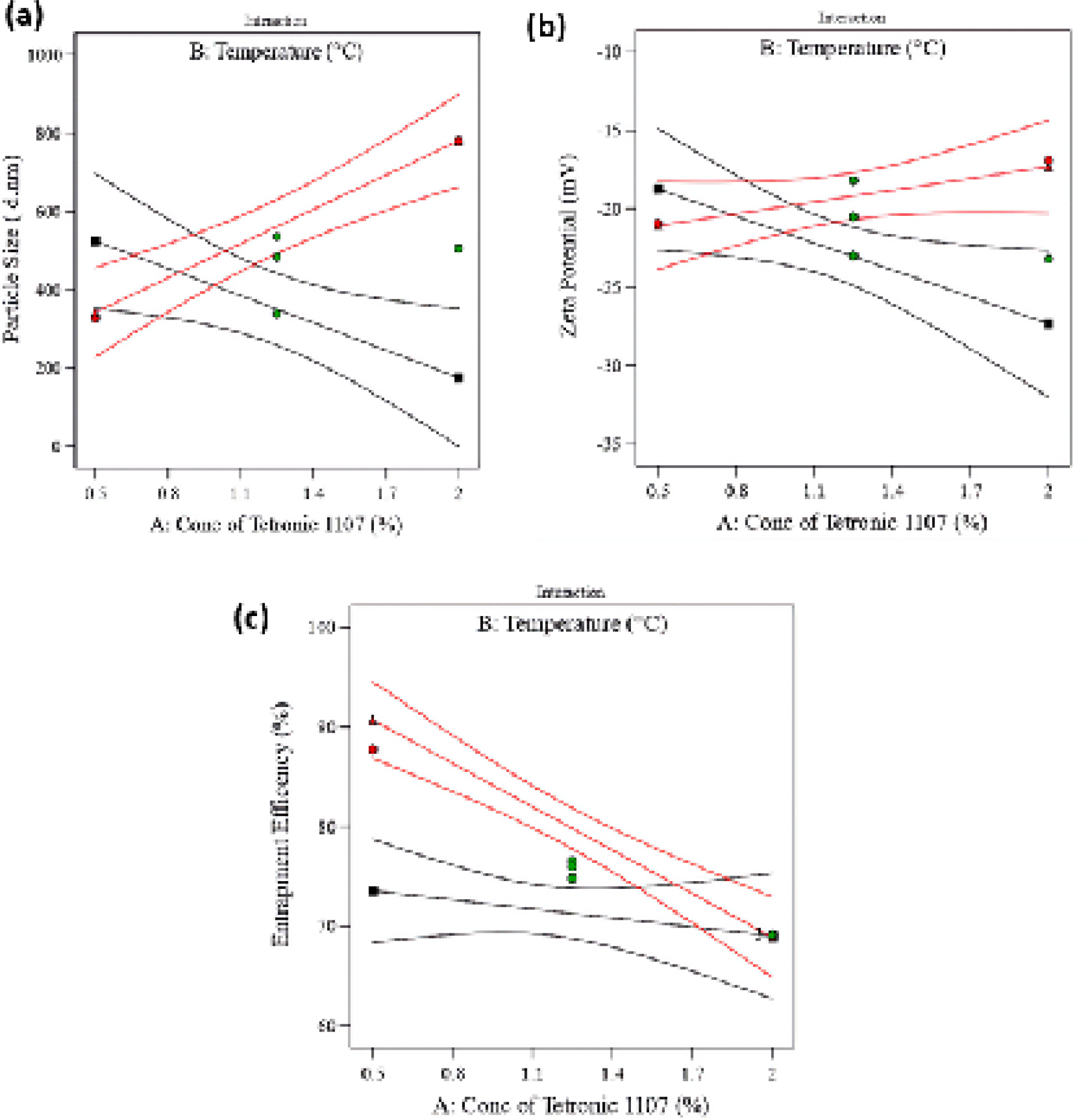
Figure 4:
Interaction plots: (a) particle size, (b) zeta potential, and (c) entrapment efficiency; diverging lines indicate significant A × B interaction.

Figure 5:
Particle size model diagnostics: (a) normal probability; (b) residuals vs. predicted; (c) Box-Cox plot.
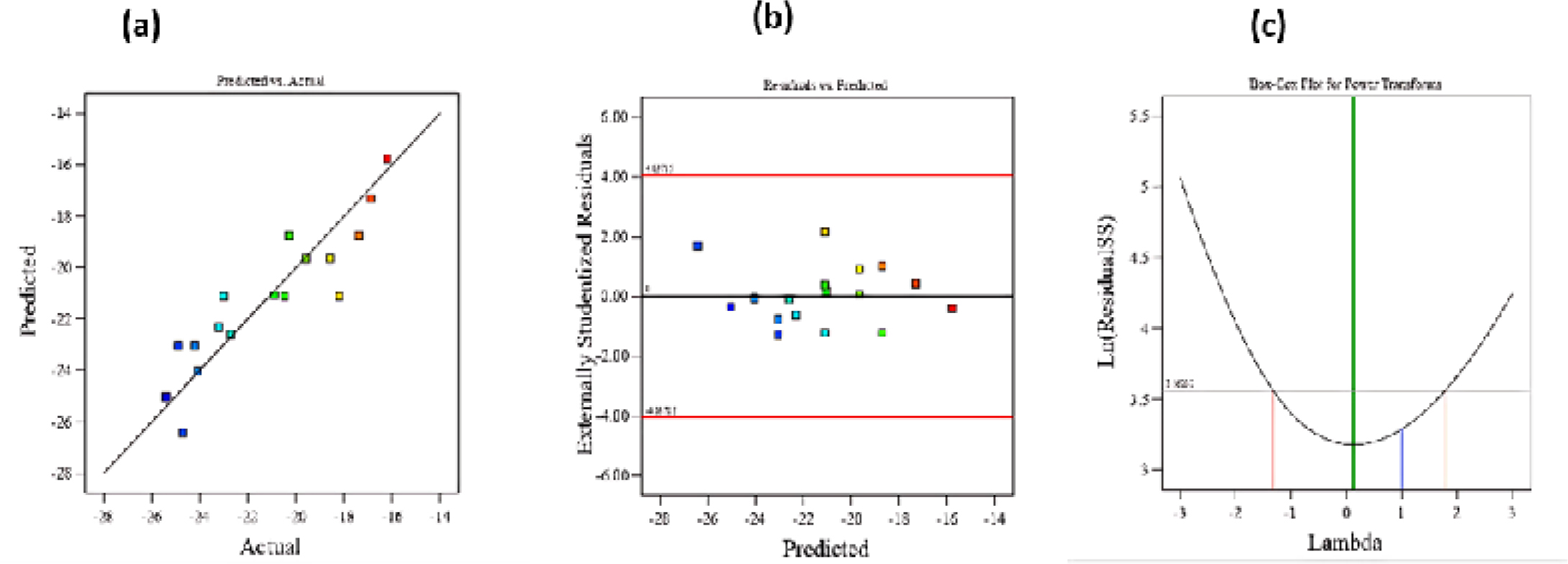
Figure 6:
Zeta potential model diagnostics: (a) normal probability plot; (b) residuals vs. predicted; (c) Box-Cox plot.

Figure 7:
Entrapment efficiency model diagnostics: (a) normal probability plot; (b) residuals vs. predicted; (c) Box-Cox plot.
| Evaluation Parameters | Particle Size (Y1) | Zeta Potential (Y2) | Entrapment Efficiency (Y3) |
|---|---|---|---|
| Model | Quadratic | 2FI | 2FI |
| F-value | 18.62 | 7.52 | 24.92 |
| p-value | <0.0001 | 0.0030 | <0.0001 |
| R² | 0.8943 | 0.8187 | 0.8926 |
| Adjusted R² | 0.8463 | 0.7099 | 0.8567 |
| Predicted R² | 0.7917 | 0.6198 | 0.6647 |
| Adequate Precision | 17.27 | 10.11 | 17.26 |
| Lack of Fit(p) | 0.9448 | 0.8149 | 0.1264 |
| Statistical Significance | Yes (p<0.0001) | Yes (p=0.0030) | Yes (p<0.0001 |
Size: 455.926 + 22.339A + 105.653B + 38.7839C + 196.701B – 185C²
Zeta Potential: -21.1175 – 1.20651A + 1.9231B + 1.92133C + 3.08286AB – 2.20065AC – 1.45958BC
Entrapment Efficiency: 75.552 – 6.57224A + 4.25924B + 0.0945145C – 4.30736AB
Box-Behnken design achieved the predefined targets (≤250 nm, ≤-20 mV, ≥75% entrapment) with optimisation yielding a single operating point of maximal desirability (≈1.0). Experimental validation confirmed close agreement with predicted values, while biotin functionalisation produced a modest increase in size, a more negative surface charge, and slightly higher entrapment efficiency. Detailed values with 95% confidence intervals are provided in Table 3, and statistical significance (p<0.05) was confirmed by one-way ANOVA.
| Response | Predicted Mean±SD | 95% CI Low-High | Observed values ±SD for Uncoated Polymersomes (N=3) | Biotin Coated Polymersomes ±SD (N=3) |
|---|---|---|---|---|
| Particle Size(nm) | 209.80±63.77 | 137.06-282.55 | 199.23±8.20 | 246.63±14.75 |
| Zeta Potential (mV) | -24.03±1.64 | -26.79 to -21.28 | -21±0.62 | -26.57±1.50 |
| Entrapment Efficiency (%) | 82.03±2.32 | 79.44-84.62 | 82.33±1.79 | 85.00±1.50 |
Fourier Transform Infrared Spectroscopy (FTIR)
Biotin-coated, carboplatin-loaded Tetronic 1107 polymersomes retained poloxamine bands at 2883, 1144, and 843 cm⁻¹; gained amide I-III at 1697, 1466, and 1342 cm⁻¹; and lacked the 1700 cm⁻¹ carbonyl of crystalline carboplatin (Figure 8).

Figure 8:
FTIR spectra of optimized biotin-coated, carboplatin-loaded polymersomes.
Differential Scanning Calorimetry (DSC)
Modulated DSC of lyophilised, biotin-coated carboplatin Tetronic 1107 polymersomes showed a single endotherm (onset 48.87ºC, peak 50.64ºC, endset 53.10ºC; width ≈2.35ºC) with enthalpy -47.41 J g⁻¹. No additional endotherms appeared between 235-250ºC; the thermogram was featureless to 300ºC (Figure 9).
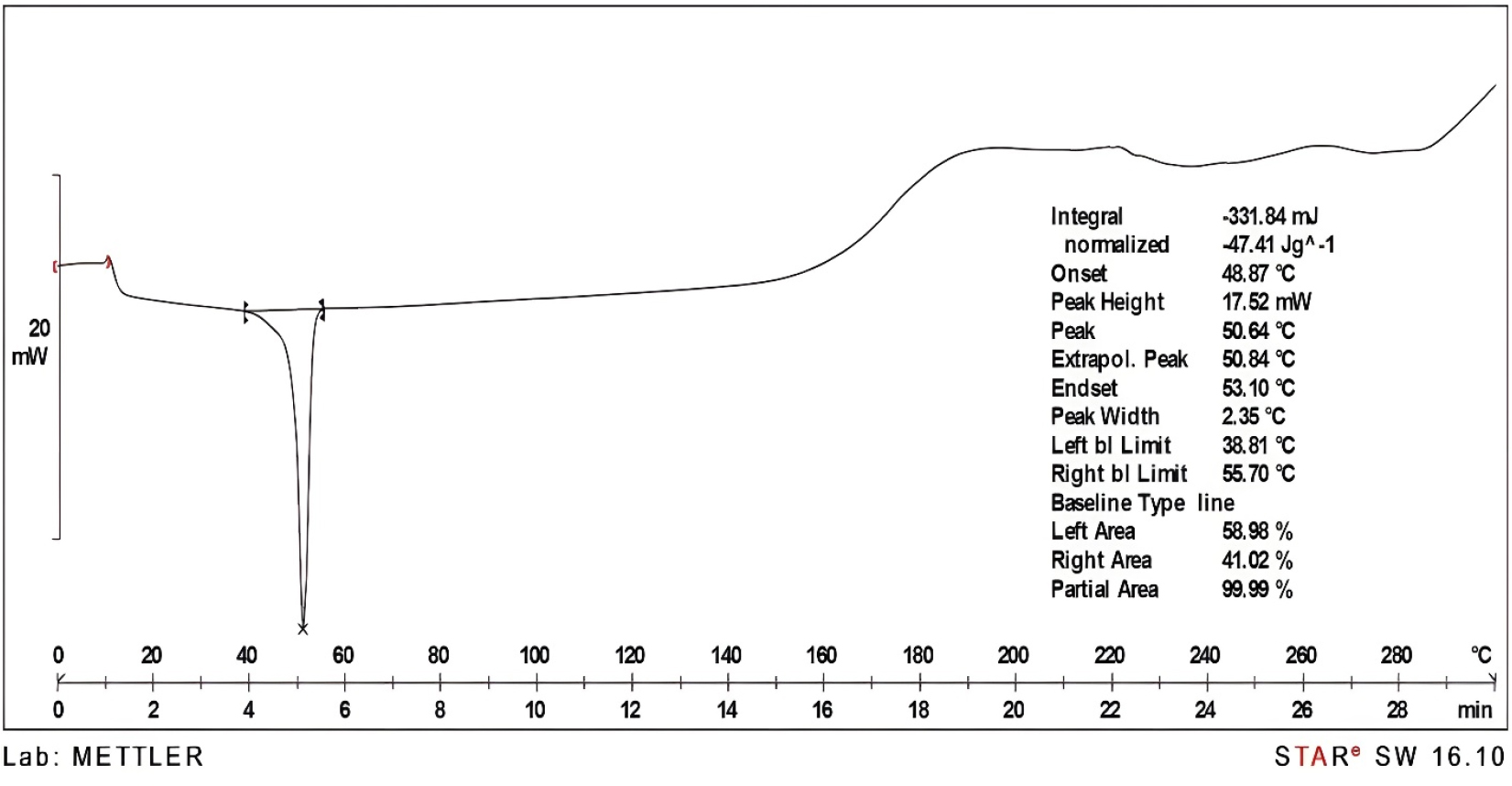
Figure 9:
DSC thermograms of optimized biotin-coated, carboplatin-loaded polymersomes.
X-ray diffraction spectroscopy (XRD)
XRD revealed a semi-crystalline Tetronic 1107 matrix with poly (ethylene oxide) doublets at 19.2° and 23.4° 2θ and no sharp carboplatin peaks. Broad shoulders 24° 2θ (FWHM 0.35°, Debye-Scherrer 22 nm) indicated nanoscale, poorly ordered domains; no Bragg reflections occurred between 5°-60° 2θ (Figure 10).
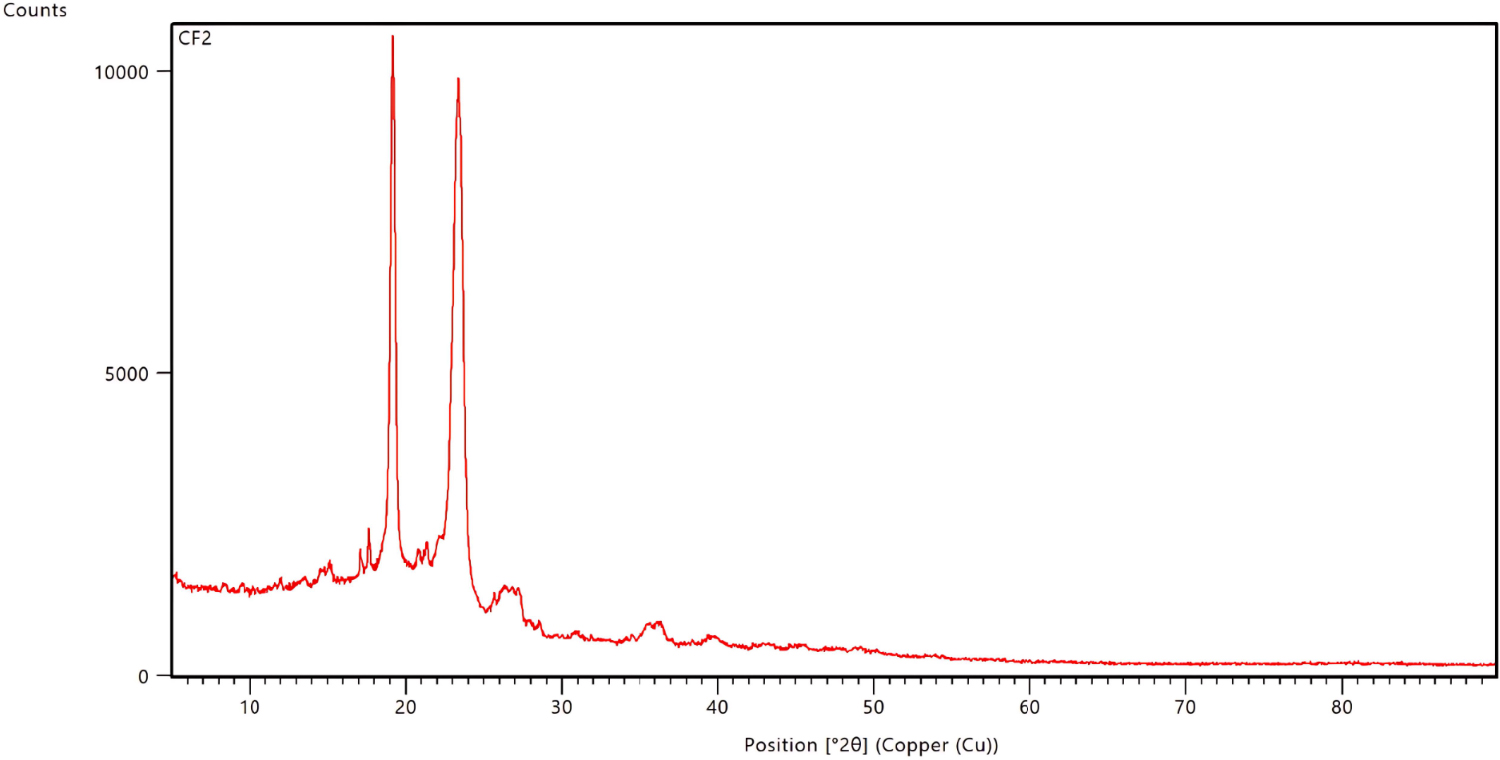
Figure 10:
XRD patterns of optimized biotin-coated, carboplatin-loaded polymersomes.
Atomic Force Microscopy (AFM) Analysis
As shown in Figures 11 and 12, AFM (uncoated vs biotin-coated) showed biotin grafting increased roughness (Sa, Sq), height, skewness, kurtosis, and entropy. Height histograms narrowed near 80 nm uncoated, then broadened and shifted to 200 nm after coating (Table 4).
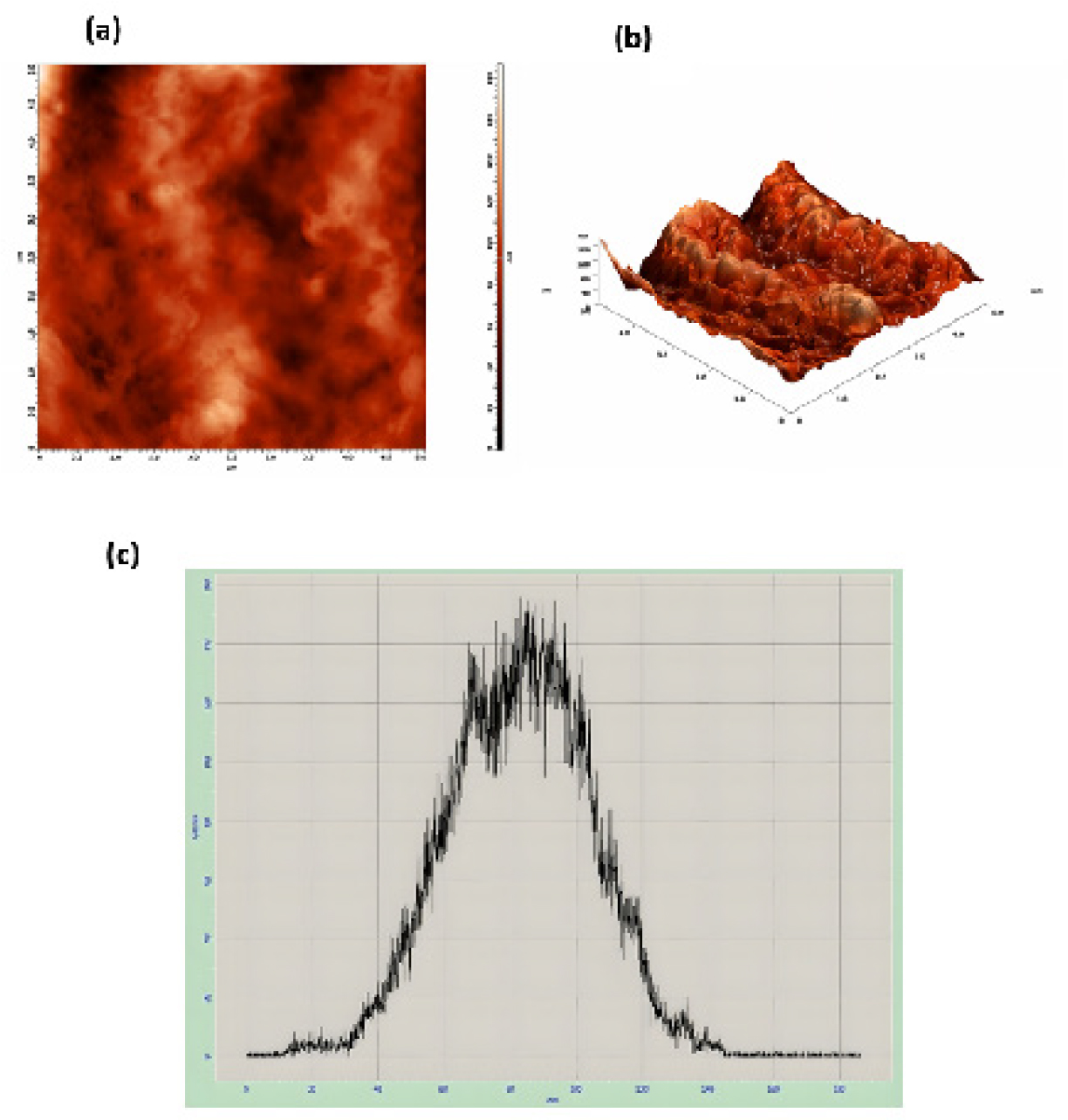
Figure 11:
AFM of uncoated polymersomes: (a) 2D height map, (b) 3D topography, (c) height distribution (90 nm).
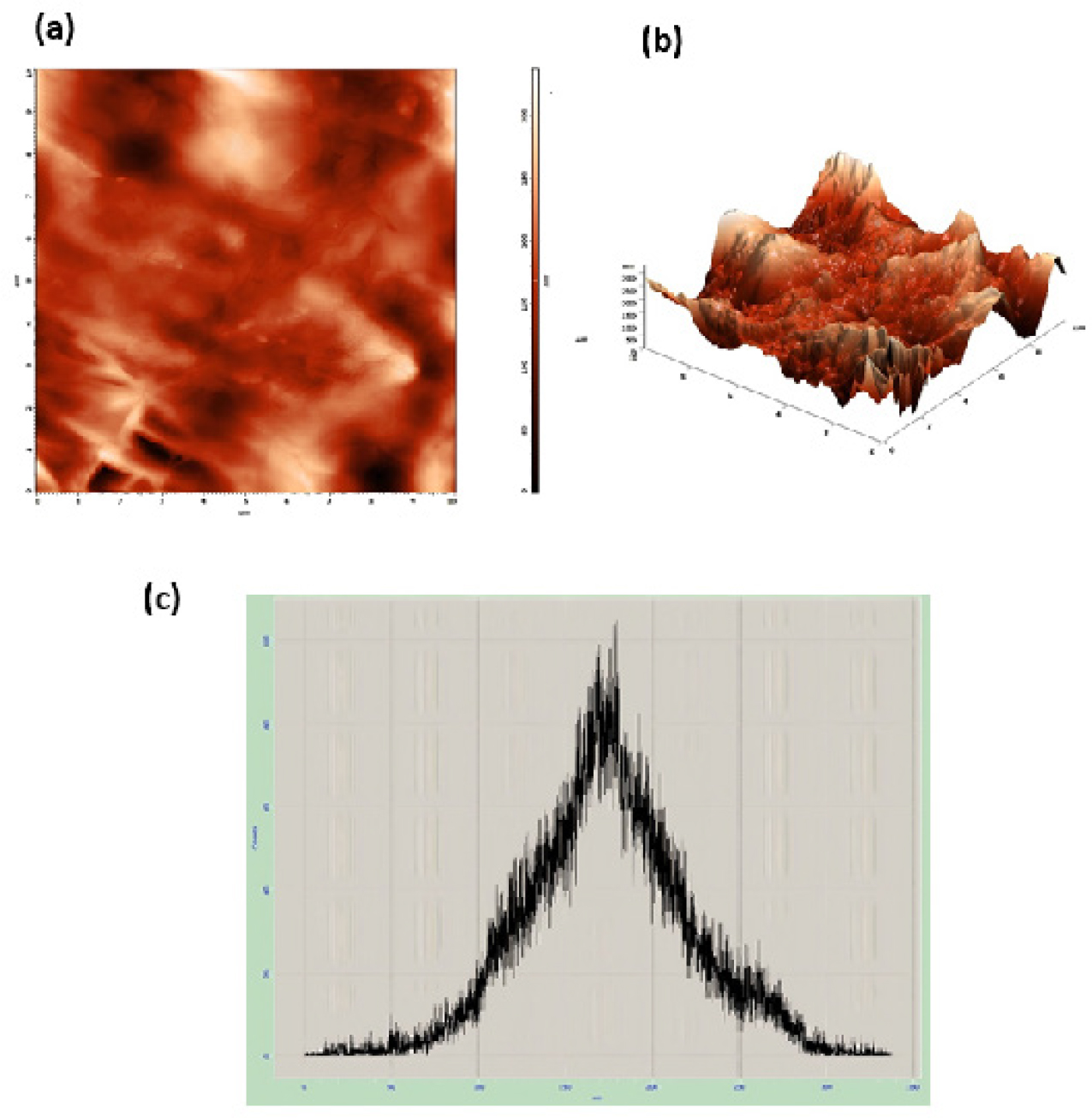
Figure 12:
AFM of biotin-coated, carboplatin-loaded polymersomes: (a) 2D height map, (b) 3D topography, (c) height distribution (150 nm).
| Parameter | Uncoated Polymersomes | Biotin coated Polymersomes |
|---|---|---|
| Sy (nm, peak-valley range) | 186.3 | 336.5 |
| Sz (nm, maximum height = Sp – Sv) | 92.8 | 168.4 |
| Mean height (nm) | 83.0 | 174.4 |
| Sa (nm, arithmetic roughness) | 17.5 | 36.2 |
| Sq (nm, RMS roughness) | 21.9 | 46.9 |
| Ssk (unitless, skewness) | -0.047 | +0.032 |
| Ska (unitless, kurtosis) | 0.184 | 0.394 |
| Shannon entropy (bits) | 9.58 | 10.66 |
| Height distribution peak (nm) | 80 | 200 |
| Distribution width (qual.) | Narrow | Broader |
Scanning Electron Microscopy (SEM)
SEM images (Figure 13) depict biotin-coated polymersomes as discrete, uniformly dispersed vesicles with submicron diameters (306-364 nm).
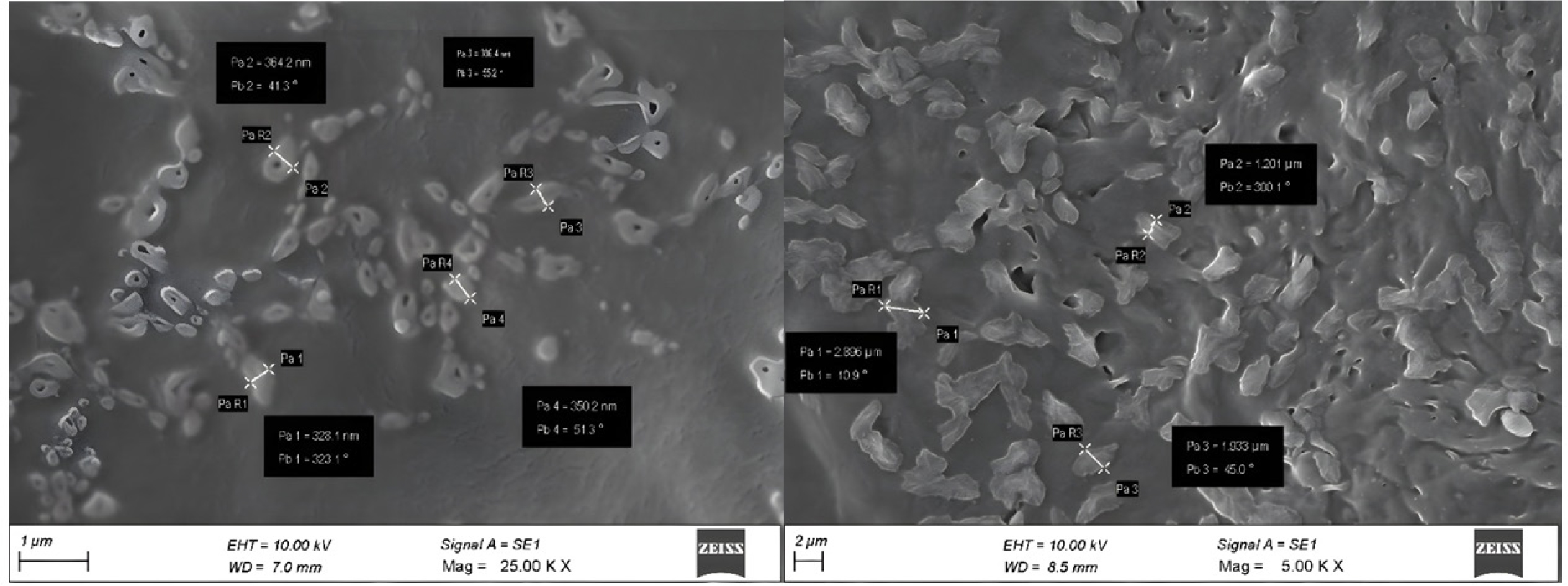
Figure 13:
SEM of biotin-coated carboplatin-loaded Tetronic® 1107 polymersomes.
In vitro drug release
Release was both pH-dependent and coating-sensitive (Figure 14). At pH 5.5, coated polymersomes released 2.8% at 5 min and 68.6% at 24 hr versus 11.5% and 78.8% uncoated. At pH 6.8, coated showed 5.6% and 89.0%, uncoated 6.4% and 94.2%. At pH 7.4, coated released 7.5% and 91.3%, uncoated 7.9% and 98.4% at 24 hr. Release profiles best fitted the Weibull model (R² ≈ 0.93-0.97).
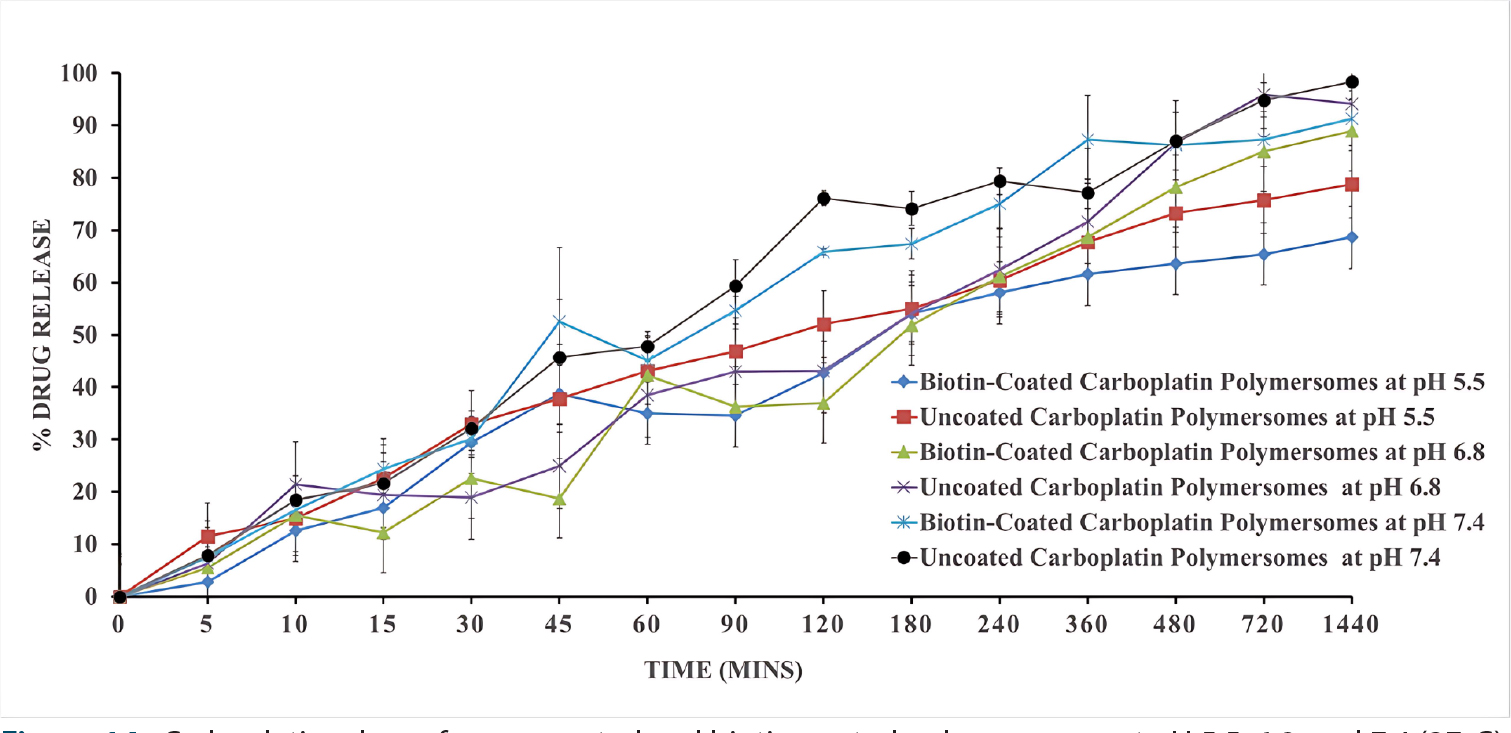
Figure 14:
Carboplatin release from uncoated and biotin-coated polymersomes at pH 5.5, 6.8, and 7.4 (37ºC).
Cytotoxicity
After 48 hr (Figures 15), A549 viability remained >94% for free carboplatin and uncoated polymersomes at ≤100 µM, while biotin-coated reduced viability to ~85% at 100 µM. At 250 µM, free drug was least effective (≈88% viability), whereas uncoated and biotin-coated reduced viability to ~67%. At 500 µM, biotin-coated produced the greatest reduction (38.5%) versus uncoated (57.3%) and free drug (72.9%). IC₅₀ values were 691 µM (free), 500 µM (uncoated), and 399.8 µM (biotin-coated), reflecting 1.73- and 1.25-fold potency gains, respectively.
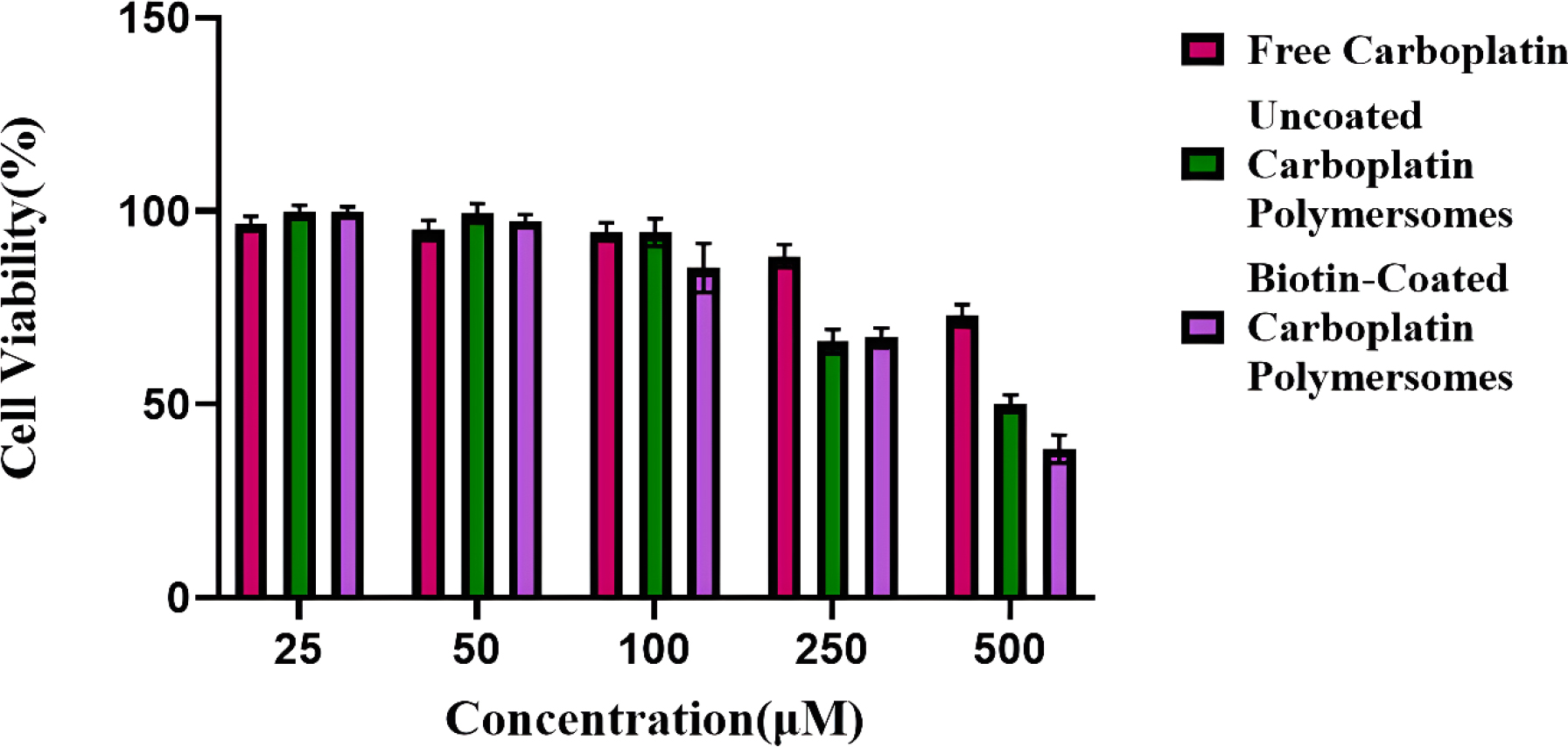
Figure 15:
A549 viability after 48 hr exposure to free carboplatin, uncoated, and biotin-coated polymersomes (MTT, mean±SD, n=3).
DISCUSSION
The quadratic model for particle size (R²=0.8943) showed temperature as the dominant driver, where elevated heat lowered interfacial tension and increased PPO mobility, promoting micelle fusion and enlargement. This effect was amplified at higher polymer levels (polymer-temperature interaction=+196.7 nm). Stirring time produced a nonlinear profile: short mixing (<0.5 hr) yielded smaller vesicles (150-180 nm), intermediate (1.25 hr) maximised coalescence (300-400 nm), while prolonged (>2 hr) reduced size (180-220 nm) through shear fragmentation. For zeta potential (R²=0.8187), the model predicted -21.1 mV, with temperature and stirring increasing values by +1.9 mV per unit. Interactions further modulated charge: the polymer-temperature interaction enhanced thermal neutralisation, the polymer-stirring interaction re-exposed anionic groups with extended mixing, and the temperature-stirring interaction slightly strengthened negative charge. All formulations remained within -12 to -25 mV, consistent with colloidal stability. Entrapment efficiency ranged from 66-88% (R²=0.8926), rising with temperature (+4.3%) and moderate polymer but declining at high polymer-temperature interaction (-4.3%). Stirring had minimal effect. Based on ANOVA showing significance without lack-of-fit, residual diagnostics confirming normality and homoscedasticity, and Box-Cox λ ≈ 1 indicating no transformation need, the models were interpreted as statistically valid and reliably predictive. Predicted optima (209.8 nm, -24.0 mV, 82.0%) closely matched experimental results (199.2 nm, -21.4 mV, 82.3%), with desirability=1.0 confirming robustness. Biotinylation modestly increased size (+47 nm), shifted ZP more negative (–5 mV), and improved EE (+3%), collectively enhancing stability and drug–polymer interactions.
FTIR confirmed PEO/PPO backbone retention with amide bands evidencing covalent biotin conjugation, while broadened ether peaks indicated hydrogen bonding and Pt(II) coordination that stabilized carboplatin in a non-crystalline form. DSC/XRD supported preserved semi-crystalline corona and amorphous drug states, ensuring stability. AFM showed roughened, protrusion-rich surfaces creating SMVT “hot spots” with enhanced interaction potential. SEM confirmed larger, corrugated vesicles after biotinylation, consistent with altered interfacial properties.
Carboplatin release followed a pH-responsive pattern: protonation at pH 5.5 compacted the PPO/PEO matrix, restricting leakage, while deprotonation at pH 7.4 enhanced chain mobility for rapid diffusion. Biotin-coated vesicles, with roughened coronas, dampened burst and extended retention, suggesting greater tumour-site availability and reduced systemic loss. Weibull modelling (R²≈0.93-0.97) indicated diffusion-erosion-controlled release.
MTT assays showed dose-dependent A549 viability reduction, with a biotinylated advantage emerging at ≥100 μM and peaking at 500 µM (biotin 38.5%<uncoated 57.3%<free 72.9%); at 250 µM, coated and uncoated were essentially equivalent (66.5% vs 67.2%; Δ0.65%). Free carboplatin was least effective, consistent with limited membrane permeability and aquation-mediated activation (Figures 16a-e). Uncoated polymersomes (199 nm; ZP=-21.4 mV) improved potency (IC₅₀ 500 µM; 1.38-fold vs free), lowered viability, and caused moderate morphological changes (rounding, reduced spread, occasional blebs, focal detachment) from 250 µM (Figures 17a-e), likely via hydrolysis protection, endocytic uptake, and sustained release (Weibull R²≈0.95). Biotin-coated vesicles produced the greatest effect (IC₅₀ 399.8 µM; 1.73-fold vs free; 1.25-fold vs uncoated), with marked shrinkage, blebbing, and widespread detachment from 250 µM, most pronounced at 500 μM (Figures 18a–e). Because size is similar (~200-250 nm) and ZP is only modestly more negative for the coated batch (-26.6 vs -21.4 mV), electrostatics/size are unlikely to be the primary drivers; the separation is best explained by ligand-receptor (SMVT) uptake requiring endocytosis and endosomal transit to achieve higher intracellular Pt accumulation.
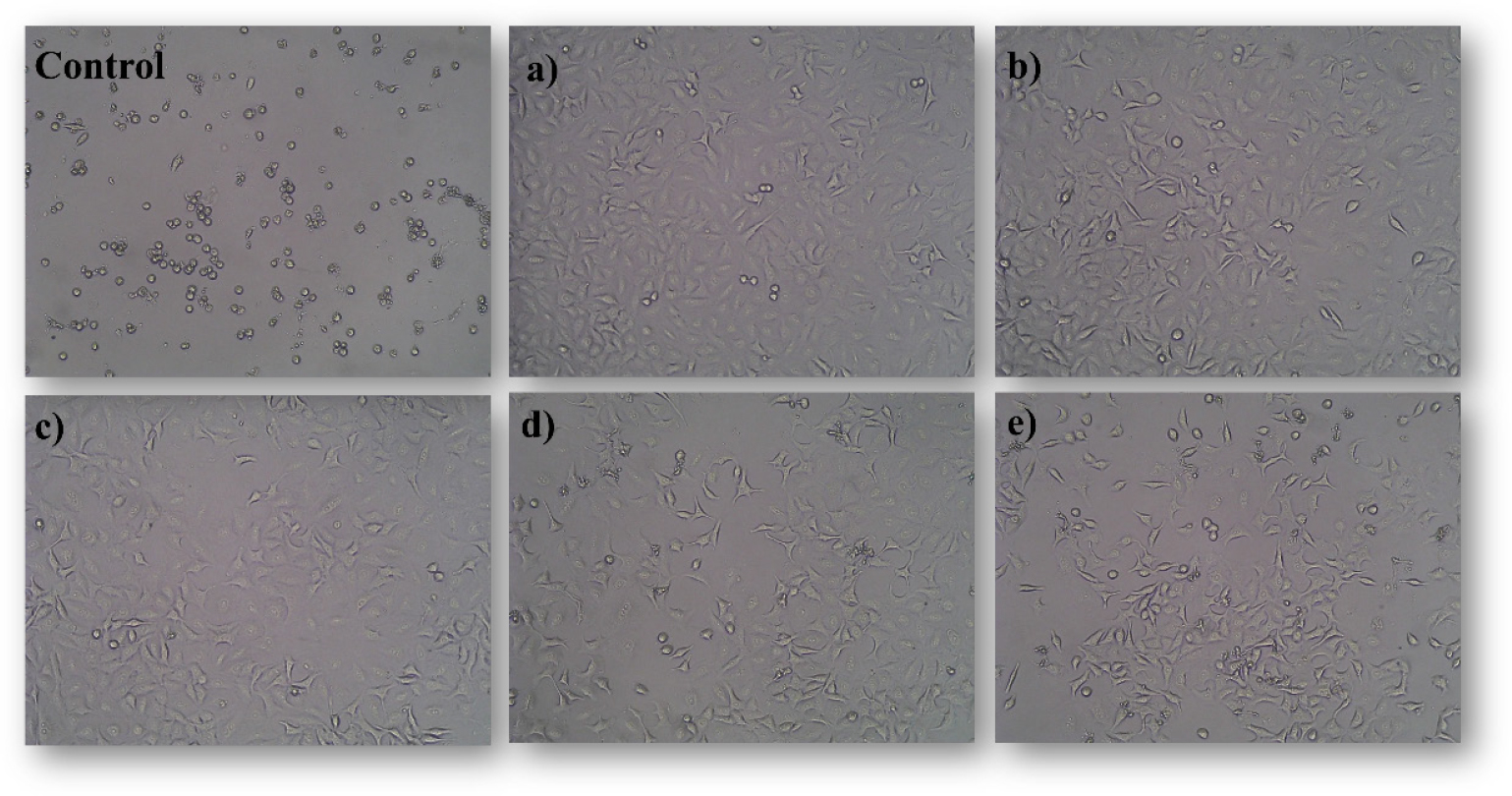
Figure 16:
Bright-field images of A549 cells after 48 hr exposure to free carboplatin: control (7.5 µM cisplatin) and (a) 25 μM, (b) 50 μM, (c) 100 μM, (d) 250 μM, and (e) 500 μM.
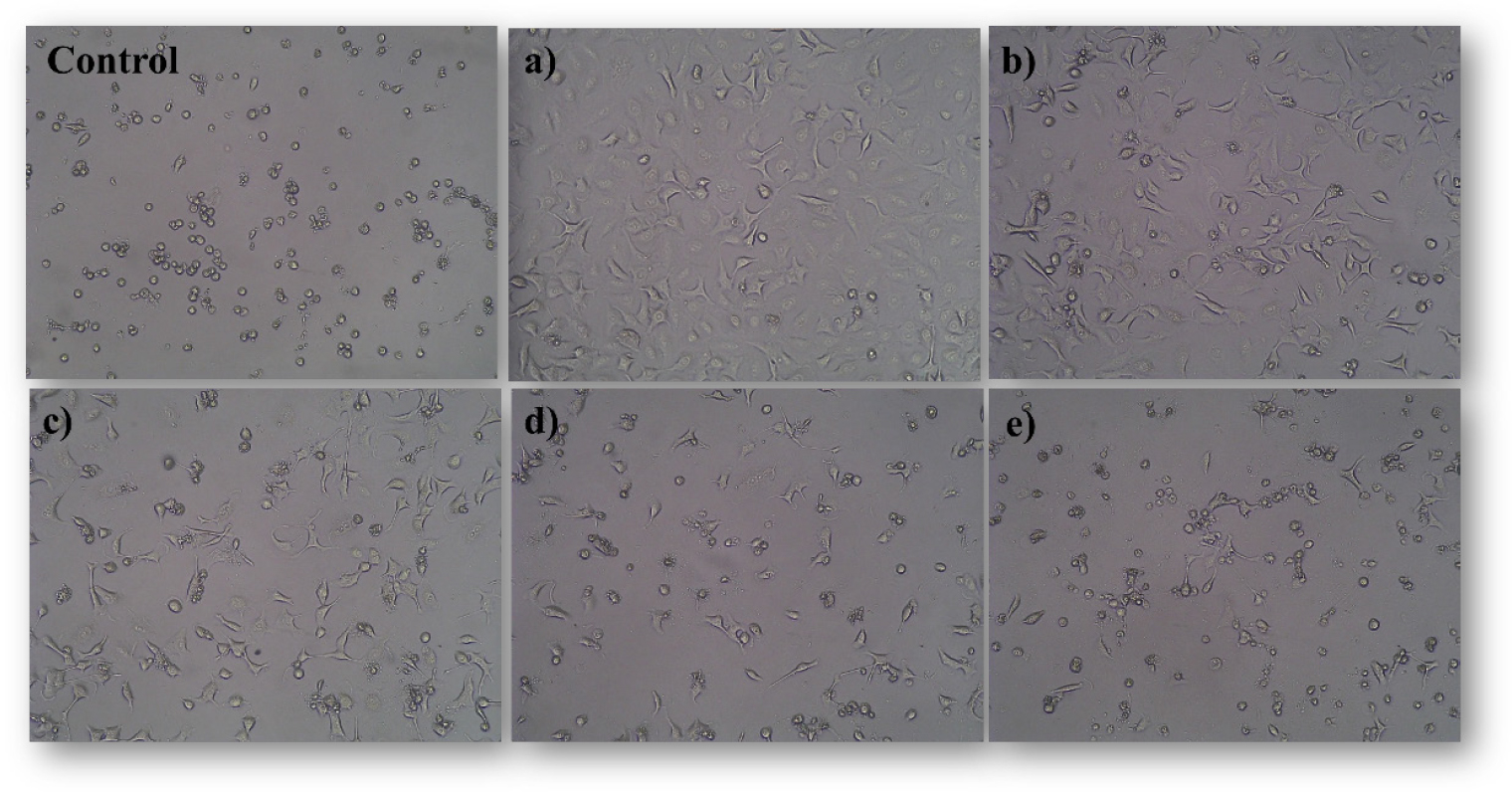
Figure 17:
Bright-field images of A549 cells after 48 hr exposure to uncoated carboplatin-loaded polymersomes: control (7.5 µM cisplatin) and (a) 25 μM, (b) 50 μM, (c) 100 μM, (d) 250 μM, and (e) 500 μM.
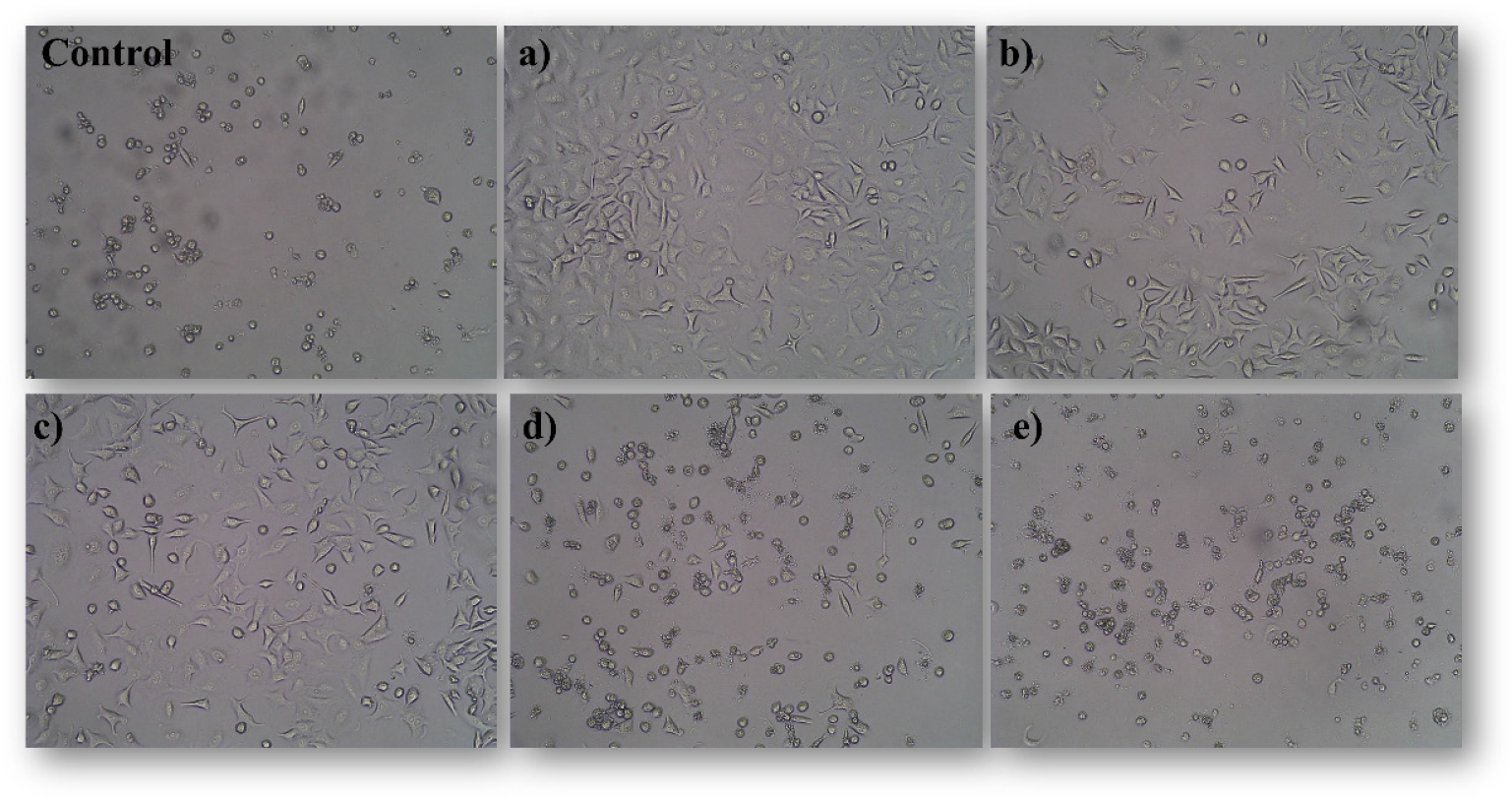
Figure 18:
Bright-field images of A549 cells after 48 hr exposure to biotin-coated carboplatin polymersomes: control (7.5 µM cisplatin) and (a) 25 µM, (b) 50 µM, (c) 100 µM, (d) 250 µM, and (e) 500 µM.
CONCLUSION
QbD-guided optimisation produced biotin-functionalised Tetronic® 1107 polymersomes (~246 nm) with high carboplatin loading and structural integrity. Spectroscopic and thermal analyses confirmed stable vesicles with a semi-crystalline PEO corona and amorphous/nanocrystalline drug state, while AFM/SEM demonstrated corrugated biotin-rich surfaces. Release was pH-responsive and governed by diffusion-erosion kinetics. In A549 cells, biotinylation enhanced uptake and retention, reducing the IC₅₀ by 1.7-fold versus free carboplatin and 1.3-fold versus uncoated vesicles. These findings highlight biotin-functionalised Tetronic® 1107 polymersomes as a stable, selective nanoplatform, warranting systematic in vivo evaluation to establish clinical translatability.
Cite this article:
Muniswamy N, Veintramuthu S, Sellappan M. Quality-by-Design Optimization of Biotin-Coated Tetronic® 1107 Polymersomes for Carboplatin Delivery in Non-Small Cell Lung Cancer. J Young Pharm. 2025;17(4):864-76.
ACKNOWLEDGEMENT
We thank PSG College of Pharmacy, Coimbatore, for facilities/support, and The Tamil Nadu Dr. M.G.R. Medical University, Chennai, for academic guidance and affiliation.
References
- Alasmary F. A., Kenawy E.-R., El-Deeb N. M., Kamoun E. A., Khattab S. A., Karami A. M., Cinelli P., Azaam M. M., et al. (2022) Synthesis, antimicrobial and anticancer activities of tetronic 1107 Schiff bases.. Polymers for Advanced Technologies 33: 2787-2797 https://doi.org/10.1002/pat.5732 | Google Scholar
- Anitha S., Ramasamy R., Nachiappa Ganesh R., Dubashi B.. (2024) Expression of the folate receptor proteins FOLR1 and FOLR2 in correlation with clinicopathological variables of gastric cancer.. In Cureus 16: Article e61032 https://doi.org/10.7759/cureus.61032 | Google Scholar
- Chen L., Zhang Z., Simonsen R. M., Owens T., Khorooshi M. H. R., Wu C., et al. (2025) Pegylated liposomes via ATRP for brain drug delivery.. Journal of Liposome Research : 1-7 https://doi.org/10.1080/08982104.2025.2485428 | Google Scholar
- Cirillo N.. (2023) The Hyaluronan/CD44 axis: A double-edged sword in cancer.. International Journal of Molecular Sciences 24: Article 15812 https://doi.org/10.3390/ijms242115812 | Google Scholar
- Dehkordi A. A., Mollazadeh S., Talaie A., Yazdimamaghani M.. (2025) Engineering PAMAM dendrimers for optimized drug delivery.. Nano Trends 9: Article 100094 https://doi.org/10.1016/j.nwnano.2025.100094 | Google Scholar
- Feng Y., Huo H., Tang Q.. (Array) Hesperidin inhibits the p53-MDMXInteraction-Induced Apoptosis of Non-Small-Cell Lung Cancer and Enhances the antitumor Effect of carboplatin.. Journal of Oncology : Article 5308577 https://doi.org/10.1155/2022/5308577 | Google Scholar
- Fonseca M., Jarak I., Victor F., Domingues C., Veiga F., Figueiras A., et al. (2024) Polymersomes as the next attractive generation of drug delivery systems: Definition, synthesis and applications.. Materials 17(4): 319 https://doi.org/10.3390/ma17020319 | Google Scholar
- Gaucher G., Dufresne M.-H., Sant V. P., Kang N., Maysinger D., Leroux J.-C., et al. (2005) Block copolymer micelles: Preparation, characterization and application in drug delivery.. Journal of Controlled Release 109: 169-188 https://doi.org/10.1016/j.jconrel.2005.09.034 | Google Scholar
- Ghaferi M., Raza A., Koohi M., Zahra W., Akbarzadeh A., Ebrahimi Shahmabadi H., Alavi S. E., et al. (2022) Impact of pegylated liposomal doxorubicin and carboplatin combination on glioblastoma.. Pharmaceutics 14: 2183 https://doi.org/10.3390/pharmaceutics14102183 | Google Scholar
- Hadisadegh S. N., Ghanbarikondori P., Sedighi A., Afyouni I., Javadpour N., Ebadi M., et al. (2024) Improving cancer therapy: Design, synthesis, and evaluation of carboplatin-based nanoliposomes against breast cancer cell lines.. Asian Pacific Journal of Cancer Biology 9: 121-127 https://doi.org/10.31557/apjcb.2024.9.2.121-127 | Google Scholar
- Ibrahim M., Ramadan E., Elsadek N. E., Emam S. E., Shimizu T., Ando H., Ishima Y., Elgarhy O. H., Sarhan H. A., Hussein A. K., Ishida T., et al. (2022) Polyethylene glycol (PEG): The nature, immunogenicity, and role in the hypersensitivity of pegylated products.. Journal of Controlled Release 351: 215-230 https://doi.org/10.1016/j.jconrel.2022.09.031 | Google Scholar
- Liu Q., Zheng H., Wang X., Zhou L., Wang S., Shen T., Ren D., et al. (2022) Cytotoxic new caged-polyprenylated xanthonoids from Garcinia oligantha.. Fitoterapia 156: Article 105092 https://doi.org/10.1016/j.fitote.2021.105092 | Google Scholar
- Mast M.-P., Modh H., Knoll J., Fecioru E., Wacker M. G.. (2021) An update to dialysis-based drug release testing—Data analysis and validation using the pharma test dispersion releaser.. Pharmaceutics 13: 2007 https://doi.org/10.3390/pharmaceutics13122007 | Google Scholar
- Millen G. C., Lawford A., Duncan C., Jenkinson H., Veal G. J., Barnett S., et al. (2024) Utility of carboplatin therapeutic drug monitoring for the treatment of neonate and infant retinoblastoma patients in the United Kingdom.. British Journal of Cancer 131: 491-497 https://doi.org/10.1038/s41416-024-02728-1 | Google Scholar
- Obreshkova D., Ivanova S., Yordanova-Laleva P.. (2022) Influence of chemical structure and mechanism of hydrolysis on pharmacological activity and toxicological profile of approved platinum drugs.. Pharmacia 69: 645-653 https://doi.org/10.3897/pharmacia.69.e87494 | Google Scholar
- Pan J., Wang Y., Chen Y., Zhang C., Deng H., Lu J., Chen W., et al. (2025) Emerging strategies against accelerated blood clearance phenomenon of nanocarrier drug delivery systems.. Journal of Nanobiotechnology 23: 138 https://doi.org/10.1186/s12951-025-03209-0 | Google Scholar
- Qiu C., Xia F., Zhang J., Shi Q., Meng Y., Wang C., Pang H., Gu L., Xu C., Guo Q., Wang J., et al. (2023) Advanced strategies for overcoming endosomal/lysosomal barrier in nanodrug delivery.. Research 6: 0148 https://doi.org/10.34133/research.0148 | Google Scholar
- Samani A., Bennett R., Eremeishvili K., Kalofonou F., Whear S., Montes A., Kristeleit R., Krell J., McNeish I., Ghosh S., Tookman L., et al. (2022) Glomerular filtration rate estimation for carboplatin dosing in patients with gynaecological cancers.. ESMO Open 7: Article 100401 https://doi.org/10.1016/j.esmoop.2022.100401 | Google Scholar
- Shi M., Anantha M., Wehbe M., Bally M. B., Fortin D., Roy L.-O., Charest G., Richer M., Paquette B., Sanche L., et al. (2018) Liposomal formulations of carboplatin injected by convection-enhanced delivery increases the median survival time of F98 glioma bearing rats.. Journal of Nanobiotechnology 16: 77 https://doi.org/10.1186/s12951-018-0404-8 | Google Scholar
- Sung H., Ferlay J., Siegel R. L., Laversanne M., Soerjomataram I., Jemal A., Bray F., et al. (2021) Global cancer statistics 2020: GLOBOCAN estimates of incidence and mortality worldwide for 36 cancers in 185 countries.. CA: A Cancer Journal for Clinicians 71: 209-249 https://doi.org/10.3322/caac.21660 | Google Scholar
- Sweed N. M., Elbalkiny H. T., Magdy E., Ramadan M., Mahmoud S., Mohamed T., Mannaa I. S., Zaafan M. A., et al. (2025) Optimization of linagliptin-loaded polymersomes via response surface methodology: A repurposed therapeutic strategy for hepatic encephalopathy prevention.. Journal of Drug Delivery Science and Technology 108: Article 106855 https://doi.org/10.1016/j.jddst.2025.106855 | Google Scholar
- Umar S., Samokhvalov A.. (2024) Encapsulation of gemcitabine on porphyrin aluminum metal–organic framework by Mechano-chemistry, delayed drug release and cytotoxicity to pancreatic cancer PANC-1 cells.. Molecules 29: 3189 https://doi.org/10.3390/molecules29133189 | Google Scholar
- Wang C., Xiu Y., Zhang Y., Wang Y., Xu J., Yu W., Xing D., et al. (2025) Recent advances in biotin-based therapeutic agents for cancer therapy.. Nanoscale 17(4): 1812-1873 https://doi.org/10.1039/D4NR03729D | Google Scholar
- Warekar D., Kurup N.. (2025) Quality by design assisted optimization of gemcitabine loaded nanocochleates.. Indian Journal of Pharmaceutical Education and Research 59: 1007-1015 https://doi.org/10.5530/ijper.20250838 | Google Scholar
- Zhang C., Xu C., Gao X., Yao Q.. (2022) Platinum-based drugs for cancer therapy and anti-tumor strategies.. Theranostics 12: 2115-2132 https://doi.org/10.7150/thno.69424 | Google Scholar
